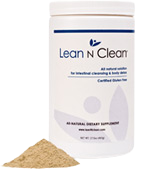Is Your Cholesterol Too High?
IF you are diagnosed with high cholesterol and your doctor want to prescribe medications for you, but you do not want to take the prescriptions drugs because you are afraid of the side effects of the drugs or you are actually suffering the side effects of these drugs, you have come to the right place and found the right product-Lean N Clean®. In a nutshell, Lean N Clean® is a safe formula that can lower cholesterol naturally over time without incurring unwanted side effects. Please keep reading for more information.
Lean-N-Clean® contains the following cholesterol-lowering ingredients:
- Psyllium
- Guar Gum,
- Alfalfa leaf,
- Irish Moss,
- Dandelion Root
- Apple Pectin

Psyllium husk and guar gum are viscous water-soluble fibers. A large number of clinical and animal studies have been conducted to test the cholesterol-lowering effects of various sources of dietary fiber. Several conclusions can be drawn from these studies. Wheat bran and cellulose, both sources of non-viscous, insoluble complex carbohydrates, do not lower plasma cholesterol level. In contrast, guar gum, psyllium husk, pectin, oat bran, beans (legumes), and fruits and vegetables have been reported to lower plasma cholesterol and especially LDL, which is considered the “bad” cholesterol. Several mechanisms have been proposed whereby sources of fiber affect cholesterol metabolism. These include increasing the fecal excretion of bile acids, slowing the rate of lipid absorption, and enhancing the production of short-chain fatty acids by complex carbohydrate fermentation in the large bowel.
Alfalfa leaf
Alfalfa leaf has been shown in animal studies to reduce blood cholesterol and plaque deposits on artery walls.
Irish Moss
Irish moss is a seaweed. Carrageenan, a constituent of Irish Moss, guards against fat and cholesterol buildup and thus inhibits arteriosclerosis.
Dandelion Root
Dandelion root is an herb with long history of safety profile. It increases the bile flow from the liver, thus increasing the metabolism of fat and cholesterol and making it one of the best IBS remedies.
Apple Pectin
Apple pectin is a soluble fiber, has been verified by recent scientific research to be effective in lowering cholesterol levels. These natural ingredients work together to help you lower your blood cholesterol level, decrease the plaque buildup on artery walls, and as a result, help reduce blood pressure as well as the chance of heart disease.
Understanding Cholesterol in Conventional Simplified Terms
People often associate the word “cholesterol” with heart attack, yet cholesterol is an important steroid that makes up the structural basis of steroid hormones, vitamin D, plasma membranes and bile salts, which is needed in the digestion of fat. What is so wrong with high cholesterol level? Lets try to understand it in a simplified fashion.
About 15% of blood cholesterol comes from one’s diet. The other 85% is made by the liver. Fats (lipids) and cholesterol are completely insoluble in water and therefore do not circulate free in the blood stream. They are transported to and from tissue cells in body fluids bound to small lipid-protein complexes called lipoproteins. Lipoproteins vary considerably in their fat-protein compositions. In general, the higher the percentage of lipids in the lipoprotein, the lower its density; and the greater the proportion of protein, the higher its density. On this basis, cholesterol is differentiated into high density lipoprotein (HDL’s) and low density lipoproteins (LDL’s).
The role of LDL’s is to transport cholesterol to the peripheral tissues for hormone synthesis and for storage for later use. The major function of HDL’s is to transport cholesterol from the peripheral tissues to the liver, where it is broken down and becomes part of the bile. It is not enough to simply measure total cholesterol. The manner in which the cholesterol is being transported in the blood is more important. As a rule of thumb, high levels of HDL’s are considered as good because the transported cholesterol is destined for degradation. High LDL levels are considered bad, because when LDL’s are excessive, potentially lethal cholesterol deposits are laid down in the artery walls.
Animal products are usually high both in saturated fats and cholesterol. Based on the observation of the typical American diet, it is clear that the major cause of too much cholesterol in the body is the over consumption of high saturated fat, high cholesterol foods. Other contributing factors to increased LDL levels and coronary artery disease are cigarette smoking, coffee drinking, excessive alcohol intake, sugar, and stress. Regular aerobic exercise lowers LDL levels and increases the levels of HDL’s. Chronically elevated blood cholesterol leads to arteriosclerosis (hardening and thickening of the arteries), high blood pressure and risk of excessive clotting. Heart disease is very rare when the blood cholesterol level is at 150 mg/dl. The majority of heart attacks occur in people with cholesterol levels in the range of 200-250 mg/dl.
The expert panel of National Cholesterol Education Program (NCEP) has recommended keeping total blood cholesterol level less than 200 mg/dl and LDL level less than 130 mg/dl. However, the CHOLESTEROL-HEART HYPOTHESIS has been under challenge for many years. To read and understand the CHOLESTEROL-HEART HYPOTHESIS challenge, please click this link: Dangers of Statin Drugs or keep reading below.Post author:
Cholesterol-lowering drugs
Cholesterol-lowering drugs can be grouped into three classes:
–HMG-CoA Reductase Inhibitors (also called “statins”)
–Bile Acid Sequestrants
–Others
HMG Co-A Reductase Inhibitors (Statins)
These are considered drugs of second choice, but are the most popular. Most new drugs for reducing high cholesterol levels are from this class.
Drug Names: Mevacor (lovastatin), Pravachol (pravastatin), Zocor (simvastatin), Lipitor (Atovastatin), Baycol (cerivastatin), Lescol (fluvastatin).
How do statins work? They inhibit the enzyme – HMG Co-A Reductase, which catalyzes cholesterol synthesis. They increase the HDLs and decrease the LDLs. However, the effects of these induced changes in lipoprotein levels on heart diseases and resulting death rate has not been established.
Dangers of Statin Drugs. Is the “Cholesterol-Heart-Theory” true?
Many people, especially those over 50, are taking Statin drugs as prescribed by their doctors as preventive medicine in hope of preventing heart diseases and extend their lifespan by lowering their cholesterol levels based on the Cholesterol – Heart Hypothesis (theory). Is this theory true? Are you aware of the dangers of Statin drugs? Are you the unwitting victim of the “Statins – Cholesterol – Heart Hypothesis” that has created a multi-billion-dollar industry? If you are one of those people taking statins, you owe it to yourself to educate yourself. Keep reading to learn more.
Bile Acid Sequestrants: (bile acid sequestering resins)
They are considered drugs of first choice.
Drug names: Questran (cholestyramine), Colestid (colestipol HCl).
During normal digestion, bile acids are secreted in the bile from the liver and gall bladder into the intestines to emulsify the fat materials in food, thus facilitating absorption. A major portion of the bile acids secreted is reabsorbed from the intestines and returned to the liver. Bile acid sequestering resins bind bile acids in the intestines to form insoluble complex which is excreted in the feces. The increased fecal loss of bile acids leads to an increased oxidation of cholesterol to bile acids and decrease in LDL’s ( the bad cholesterol).
Precautions: The major drawback of these drugs is malabsorption. Because they tie up the bile acids which are responsible for normal fat digestion and absorption, they prevent absorption of fat-soluble vitamins such as A, D. E and K as well. Deficiency in Vitamin K will increase bleeding tendency. Reduction of folic acid in blood has been reported over long term use of cholestyramine. Folic acid is needed for the formation of new red blood cells. These drugs may produce or severely worsen preexisting constipation. Fecal impaction may occur and hemorrhoids may be aggravated.
Others
Lorelco (probucol), Choloxin (Dextrothyroxine Sodium) Atromid-S (clofibrate), Lopid (gemfibrozil)
All these drugs have various adverse effects involving different organs of our bodies. Impotence seems to be one of the common side effects of most drugs for reducing high cholesterol levels.
Warnings (Cholesterol-lowering Drugs)
Liver damage
Including hepatitis, liver cirrhosis and cholestatic jaundice, more severe when taken by people who consume substantial quantities of alcohol. Liver function tests are recommended every 4 to 6 weeks during the first 3 months of therapy, every 6 to 8 weeks during the next 12 months and periodically thereafter (approximately 6 month intervals).
Note: Liver function tests only tell you when you are starting to suffer detectable liver damage. They serve no purpose in correcting the problem created by these drugs. Usually our livers can suffer extensive damage before they will show abnormalities in tests.
Skeletal muscle effects
Destruction of skeletal muscle with abnormal kidney function has occurred to some patients taking the statins. A small percentage of patients may develop myopathy (i.e., myalgia – muscular pain or muscle weakness.)
Carcinogenesis/Fertility impairment
A study n mice has shown a statistically significant increase in liver cancer although the dosage was over 300 times the maximum recommended human dose.
Other warnings and adverse effects include, but are not limited to: Central nervous system vascular lesions, characterized by hemorrhage and edema, renal function impairment, impotence, loss of libido, and hair loss.
DISCLAIMER: Individual result may vary.
Products
Lean N Clean®
Digestive Issues
- Diverticulitis
- Crohn’s Disease
- Celiac Disease
- Irritable Bowel Syndrome (IBS)
- Constipation
- Hemorrhoids
- Acne Cure and Prevention
- Bad Breath Cure and Prevention
- How to Regulate Your Bowel
Cleansing Benefits
Digestive Health
- Visit www.acidgone.com to learn about our Acid Reflux/GERD/heartburn- product- Acidgone®
- Read About How You Can Avoid Being a Willing Medical Victim on willingmedicalvictims.org
- Are you an independent thinker? Share your important thoughts to benefit humanity on debateandshare.com

